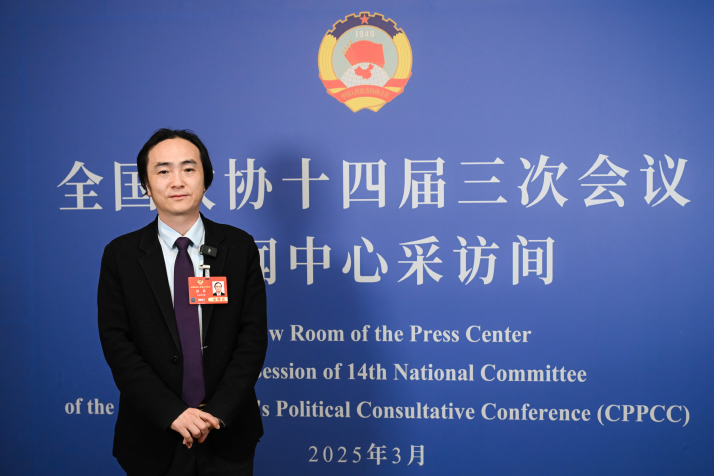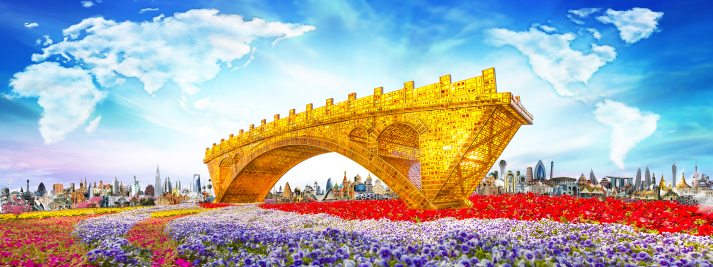| Real People, Real Lives |
| Shu Yong: Building a cultural golden bridge to connect the world | |
|
|
|
|
|
In Huangcun Town of suburban Daxing District in south Beijing, a unique space blends quietly into the community: the Shu Yong Museum of Modern Art. Local residents often drop by to view its vibrant exhibits, and sometimes, Shu Yong, founder and curator of the museum, greets them in person—guiding tours, explaining his artworks and listening closely to the visitors' feedback.
"We built this museum near residential areas so that their residents could immediately engage with high-quality art," Shu told Beijing Review. "These interactions not only enrich their lives, but also help me a lot when drafting proposals for state administration as a member of the Chinese People's Political Consultative Conference (CPPCC) National Committee." The CPPCC National Committee is China's top political advisory body.  Shu Yong, a member of the 14th Chinese People's Political Consultative Conference (CPPCC) National Committee, China's top political advisory body, attends its third session in Beijing in early March (COURTESY PHOTO)
Golden bridge
Shu, Vice President of the Kaiming Painting Institute, has spent over 30 years as a cultural and artistic innovator. His most iconic work is Golden Bridge on Silk Road, which emerged from an earlier project titled Google Bricks. Unveiled at the 2012 Venice Biennale, an biennial international art exhibition held in Venice, Italy, Google Bricks is a wall made of 1,500 translucent bricks, each inscribed with Chinese social media catchphrases that were translated into English via Google Translate. The often awkward translations—like hongbao (a gift of money given during holidays or special occasions), literally rendered as "red envelope"—highlighted the cultural gaps between East and West. For Shu, the installation symbolized the invisible walls between civilizations. But rather than stopping there, he resolved to tear down walls and build bridges between civilizations through art. In 2013, Chinese President Xi Jinping proposed the Belt and Road Initiative (BRI) to boost connectivity along and beyond the ancient Silk Road routes, advocating the Silk Road spirit of peace and cooperation, openness and inclusiveness, mutual learning and mutual benefit. Inspired by this vision, Shu began creating Golden Bridge on Silk Road, an installation crafted with translucent amber bricks the size of the Great Wall bricks which are embedded with the floral emblems of BRI-participating countries. The Great Wall, a UNESCO World Heritage Site, is a military defense project of ancient China. It consists of many interconnected walls, some dating back 2,000 years. Generally, bricks used to build the Great Wall in the Ming Dynasty (1368-1644), which form the most visible parts of the historical and cultural wonder today, measure 37 cm long, 15 cm wide and 9 cm thick. With 20,000 such bricks, Shu built a golden bridge modeled after the Zhaozhou Bridge, China's oldest standing bridge and the oldest stone segmental arch bridge, located in Zhaoxian County, Hebei Province, dating back over 1,400 years. The result was a dazzling 28-meter-long, 100-ton bridge shimmering in golden hues, symbolizing cultural inclusivity and global solidarity.  An oil painting featuring the Golden Bridge on Silk Road installation, created by Shu (COURTESY PHOTO)
"This work draws from China's rich traditional culture and the vision of a community with a shared future for humanity. I hope to express the idea that 'a single flower does not make spring; only when a hundred flowers bloom together does spring fill the garden'," Shu explained, referencing a Chinese saying that emphasizes the importance of diversity and inclusion. "And bridges are universal symbols in public art, they instantly connect people, regardless of background." When Golden Bridge on Silk Road debuted at the World Expo 2015 in Milan, Italy, it drew crowds from across the globe. Visitors searched for their own country's national flower, snapping photos in front of the section that represents them. It has also become a partnership project of UNESCO's Silk Road Program. "For me, this bridge speaks to our shared longing for peace, cooperation and mutual respect," Shu said. "So many of today's global conflicts stem from misunderstandings. But if we build bridges—especially cultural ones that connect hearts—we can create a more beautiful world." Over the past decade, Golden Bridge on Silk Road has been featured at the venues of the three editions of the Belt and Road Forum for International Cooperation in Beijing in 2017, 2019 and 2023, the Beijing Summit of the Forum on China-Africa Cooperation in 2018 and the Conference on Dialogue of Asian Civilizations in 2019. Heads of state from over 20 countries have signed the artwork, helping it evolve into a globally recognized cultural symbol. In 2024, Shu initiated the Golden Bridge 100 Cities Program, planning to build a sculpture in the shape of a local bridge in each of the 100 participating cities around the world. "Cultural symbols created in China are not exclusive to China. They belong to humanity," Shu emphasized. Art for the future As a CPPCC National Committee member, Shu is constantly exploring how to make art more accessible—not just to appreciate, but to create. On the fourth floor of his museum, Google Bricks and Golden Bridge on Silk Road are displayed together. Between them stands another installation titled The New Era: Ready for Takeoff, created with contributions from 10,000 children invited by Shu. Each child crafted a paper airplane and wrote their dreams for the future on its wings. "I placed their work next to mine to show that children's creativity is just as valuable," Shu explained. "I want them to feel the joy of artistic expression and the spark of imagination." In recent years, Shu has embraced AI as a new artistic tool. Since 2023, he has been exploring how AI can democratize art creation. "In the past, many people lacked the skills to realize their artistic visions," he said. "But with AI, anyone can describe an idea in words and watch it come to life visually. This lowers barriers and expands creative potential across society." In 2024, Shu curated an AI art exhibition for children. He was amazed at how quickly kids learned to use AI tools and how imaginative their outputs were, often surpassing those of adults. At the annual session of the CPPCC National Committee in Beijing in March, Shu submitted eight proposals, covering topics including guiding AI development with traditional Chinese culture and enhancing vocational education on automation and unmanned technologies. In the proposals, Shu emphasized the need to accelerate efforts to raise AI literacy among the public. Additionally, he called for efforts to promote widespread engagement in cultural creation and exchange through AI platforms, laying a solid foundation for the global promotion of Chinese culture. "And when culture crosses borders, it connects the world," he concluded. Copyedited by G.P. Wilson Comments to wangruohan@cicgamericas.com |
|
||||||||||||||||||||||||||||
|